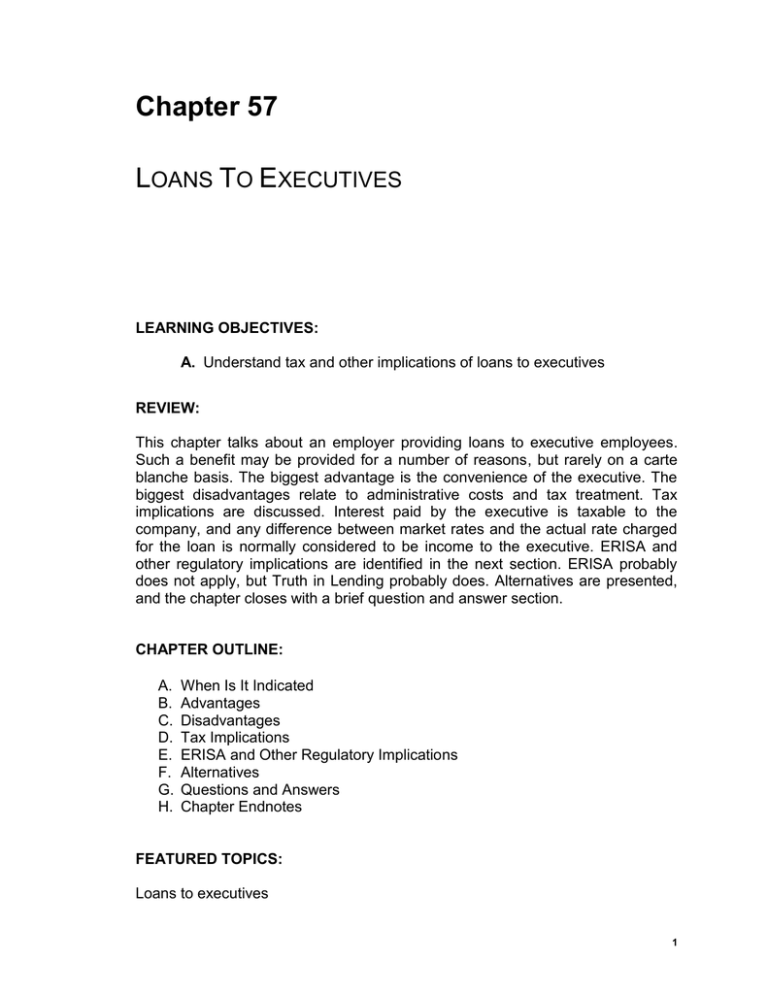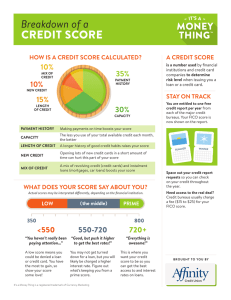Chapter 57
advertisement

Chapter 57 LOANS TO EXECUTIVES LEARNING OBJECTIVES: A. Understand tax and other implications of loans to executives REVIEW: This chapter talks about an employer providing loans to executive employees. Such a benefit may be provided for a number of reasons, but rarely on a carte blanche basis. The biggest advantage is the convenience of the executive. The biggest disadvantages relate to administrative costs and tax treatment. Tax implications are discussed. Interest paid by the executive is taxable to the company, and any difference between market rates and the actual rate charged for the loan is normally considered to be income to the executive. ERISA and other regulatory implications are identified in the next section. ERISA probably does not apply, but Truth in Lending probably does. Alternatives are presented, and the chapter closes with a brief question and answer section. CHAPTER OUTLINE: A. B. C. D. E. F. G. H. When Is It Indicated Advantages Disadvantages Tax Implications ERISA and Other Regulatory Implications Alternatives Questions and Answers Chapter Endnotes FEATURED TOPICS: Loans to executives 1 Chapter 57 CFP® CERTIFICATION EXAMINATION TOPIC: NONE COMPETENCY: Upon completion of this chapter, the student should be able to: 1. Understand tax and other implications of loans to executives DISCUSSION: 1. Discuss why an employer might provide a loan to an employee. 2. Discuss tax implications for below-market and compensation-related loans. KEY WORDS: Legal services plan Prepaid legal services plan Scheduled benefits Comprehensive benefits Indemnity basis Prepayment basis Open-panel prepayment plan Closed-panel prepayment plan QUESTIONS: 1. Which of the following are true regarding loan interest actually paid by an employee to the lender-employer? (1) interest is considered taxable income to the company (2) interest may be deductible for the employee (3) any difference between loan interest rate and current market rate is considered income paid by the employer to the employee (4) the employer cannot deduct any interest amount considered to be additional compensation to the employee a. b. c. d. (1) only (1) and (2) only (1) (2) and (3) only (2) (3) and (4) only Chapter 57, p. 412 Chapter 57 2. Which of the following are requirements that must be met in order for a loan to qualify for the bridge loan exception? (1) the loan proceeds can only be used to purchase a principal or secondary (i.e., vacation) home (2) the loan must be payable in full 15 days after the old principal residence is sold (3) the aggregate principal of all bridge loans must not exceed a reasonable estimate of the equity in the old residence (4) the old residence must not be converted to business or investment use a. b. c. d. (1) only (1) and (2) only (1) (2) and (3) only (2) (3) and (4) only Chapter 57, pp. 412-13 3. What is the maximum possible dollar amount for a loan to be a de minimis loan? a. b. c. d. $5,000 $10,000 $20,000 $25,000 Chapter 57, p. 413 4. What impact does Sarbanes-Oxley have on personal loans from a publicly traded corporation to an employee? (1) employees who are not directors or officers can still receive loans (2) no employee can receive a loan (3) employees who are directors or officers cannot receive a loan (4) loans can be made, but only at current market rates a. b. c. d. (1) and (3) only (1) (2) and (3) only (2) (3) and (4) only (1) (2) (3) and (4) Chapter 57, p. 413 Chapter 57 ANSWERS: 1. c 2. d 3. b 4. a





